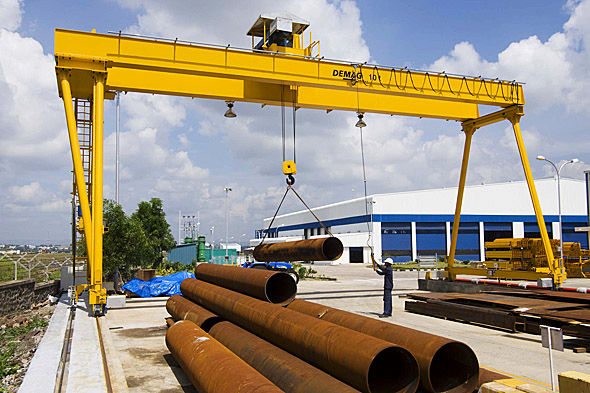In the world of industrial equipment, gantry crane have earned a reputation for being one of the most versatile and reliable tools for handling heavy loads. These cranes, characterized by a horizontal bridge that spans across two or more legs or tracks, are found in a variety of industries—from manufacturing and construction to shipping and logistics. Due to their adaptability and wide range of capabilities, gantry cranes have become indispensable for many applications that involve lifting and moving large, bulky materials.
In this blog post, we’ll dive into the many ways gantry cranes are used across different industries, exploring how their flexibility, mobility, and lifting power help businesses maximize efficiency and safety while maintaining high productivity standards.
What Are Gantry Cranes?
A gantry crane consists of a bridge that is supported by two or more legs, which can be mounted on wheels or tracks. The crane’s bridge houses the hoisting mechanism, which can lift heavy loads, while the legs provide stability and mobility. Gantry cranes are not fixed to a specific location, as traditional overhead cranes are. This allows them to move freely within a designated workspace.
Gantry cranes come in various designs, including:
-
Single Girder Gantry Cranes: Suitable for light to medium loads, these cranes feature a single beam to support the hoist.
-
Double Girder Gantry Cranes: With two parallel beams, these cranes offer greater strength and can handle heavier loads.
-
Portable Gantry Cranes: Smaller, mobile cranes designed for use in confined spaces or for lighter lifting tasks.
-
Full Gantry Cranes: Large cranes that span an entire workspace, ideal for heavy-duty operations in manufacturing, construction, and shipbuilding.
Because of their flexibility and capacity to move along tracks or wheels, gantry crane can be used in a wide array of settings and tasks. Let’s explore how different industries benefit from these powerful machines.
1. Construction: Lifting Heavy Materials with Precision
Construction sites are dynamic environments where safety, efficiency, and precision are essential. Gantry cranes play a vital role in ensuring that heavy materials, such as steel beams, concrete panels, and large prefabricated structures, are transported safely and accurately. The ability to lift and place large materials without relying on multiple pieces of equipment improves the workflow and streamlines the construction process.
Key Benefits in Construction:
-
Lifting Large Building Materials: Gantry cranes are particularly useful when working with large building materials that need to be hoisted into place. For example, lifting steel beams onto the framework of a building requires a reliable and powerful crane. Gantry cranes can safely handle these tasks, reducing the risk of accidents and delays.
-
Adaptable to Different Site Layouts: Construction sites often have limited space and difficult terrain, making it challenging to move heavy loads. Gantry cranes, with their ability to move across tracks or wheels, can be repositioned to accommodate specific tasks and reach different areas of the site, maximizing the use of available space.
-
Faster Construction Processes: By automating the lifting and moving of materials, gantry cranes help reduce the time needed for manual labor, thus speeding up the construction process and ensuring that projects meet deadlines.
2. Manufacturing: Streamlining Production and Assembly
In manufacturing plants, the ability to move heavy components efficiently is crucial to maintaining smooth production lines. Whether it’s moving raw materials, assembling large products, or transferring finished goods, gantry cranes are indispensable for ensuring the flow of materials in high-demand production environments. These cranes are used in various sectors, including automotive, aerospace, and heavy machinery manufacturing.
Key Benefits in Manufacturing:
-
Efficient Movement of Materials: Gantry cranes can lift and move large components between different stages of production. For example, in automotive manufacturing, these cranes are used to move car parts across the production line, from welding to assembly and painting. In steel manufacturing, gantry cranes are used to transport steel slabs, coils, and beams, keeping production flowing smoothly.
-
Precision Handling of Heavy Components: Many manufacturing tasks require precision when moving heavy equipment or components. Gantry cranes can be equipped with advanced hoisting systems that allow for fine control over the load, ensuring accuracy when placing parts in the correct positions.
-
Increased Flexibility: Gantry cranes can be easily adapted to meet the needs of various manufacturing processes. They can be customized with different lifting attachments or hoists to handle specific types of loads, making them suitable for a wide range of applications across different industries.
3. Shipbuilding and Marine Industry: Moving Massive Components
In shipyards and marine industries, gantry cranes are used for heavy-duty tasks like lifting large sections of ships, transferring machinery, and handling cargo. The size and weight of the materials involved in shipbuilding make it essential to have a reliable lifting system that can accommodate such heavy loads. Gantry cranes offer the capacity, mobility, and versatility needed to perform these challenging tasks.
Key Benefits in Shipbuilding:
-
Handling Large Ship Components: Shipyards use gantry cranes to lift large sections of ships, such as hulls or decks, and place them into dry docks or assembly areas. The crane’s ability to lift massive loads makes it an essential tool for shipbuilding operations.
-
Transporting Heavy Marine Equipment: Gantry cranes are also used to move heavy marine equipment, such as engines, propellers, or large tools, to different parts of the shipyard. The flexibility of the crane allows it to navigate the shipyard’s sometimes challenging layout, reducing the need for additional lifting equipment.
-
Safe and Efficient Loading/Unloading: Gantry cranes are commonly used in ports and harbors to load and unload large cargo, such as containers and bulk materials, from ships. The crane’s ability to move along tracks allows it to reach the necessary areas to handle large containers, improving the speed and safety of loading/unloading operations.
4. Logistics and Warehousing: Improving Material Flow
In logistics and warehousing, the efficient handling of materials is essential to meet tight delivery schedules and manage inventory. Gantry cranes are often employed to move goods within large warehouses, transport materials to loading docks, or transfer stock from one area to another. Their mobility and ability to handle heavy loads make them ideal for improving the flow of materials in large distribution centers.
Key Benefits in Logistics and Warehousing:
-
Fast and Safe Material Movement: Gantry cranes allow warehouse operators to move large loads, such as pallets or bulk materials, quickly and safely. This helps reduce the time spent handling materials manually, ensuring that operations are more efficient and reducing labor costs.
-
Space Optimization: Many warehouses operate in tight spaces with limited ceiling height, and gantry cranes are an ideal solution because they require less vertical clearance compared to traditional overhead cranes. This makes them perfect for optimizing space, as they can be used in areas that would otherwise be difficult to navigate.
-
Flexibility in Different Warehouse Types: From automated distribution centers to smaller warehouses with high ceilings, gantry cranes can be adapted to suit a wide range of storage environments. Their ability to move along tracks or wheels makes them versatile in environments where goods need to be quickly transferred between sections or to shipping areas.
5. Energy and Mining Industries: Handling Raw Materials
In industries such as energy and mining, gantry cranes play a critical role in transporting raw materials, such as coal, ores, or heavy machinery, within processing plants or storage facilities. These industries often work with bulk materials that require specialized equipment to move efficiently and safely.
Key Benefits in Energy and Mining:
-
Handling Bulk Materials: Gantry cranes are used to lift and transport bulk materials like coal or ores within processing plants, making them essential for industries that rely on large-scale material handling.
-
Heavy Lifting for Equipment Maintenance: In power plants and mining operations, gantry cranes are used to move large equipment, such as turbines, generators, or pumps, for routine maintenance or replacement. Their robust lifting capacity allows them to handle heavy components with ease.
-
Safety and Durability: The harsh conditions found in mining and energy production environments require lifting equipment that is durable and capable of handling heavy loads safely. Gantry cranes are built to withstand tough working conditions, ensuring the safe and efficient transport of materials and equipment.
Conclusion: The Unmatched Versatility of Gantry Cranes
Gantry cranes have proven to be invaluable tools in a wide range of industries, offering unmatched versatility in handling heavy materials and improving the efficiency of operations. From construction and manufacturing to shipbuilding and logistics, these cranes provide the mobility, lifting capacity, and precision needed for the smooth and safe movement of large and heavy items.
Their ability to be adapted to different industry needs and their ability to move across a variety of work environments make gantry cranes a vital part of any industrial operation. Whether you’re lifting materials in a construction site, assembling parts in a manufacturing plant, or loading cargo at a port, gantry cranes are the go-to solution for efficient and safe material handling.




